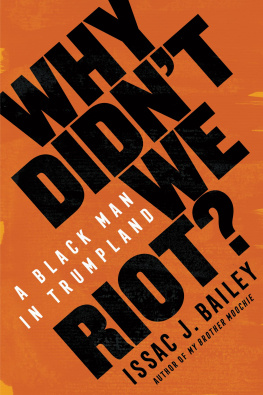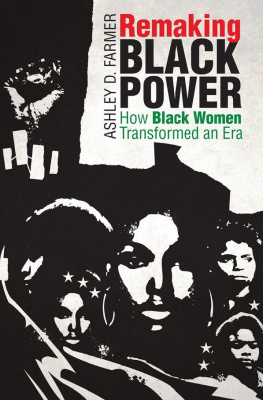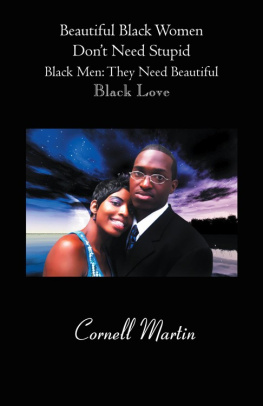
Misogynoir Transformed
Intersections: Transdisciplinary Perspectives on Genders and Sexualities
General Editor: Suzanna Walters
Sperm Counts: Overcome by Mans Most Precious Fluid
Lisa Jean Moore
The Sexuality of Migration: Border Crossings and Mexican Immigrant Men
Lionel Cant, Jr.
Edited by Nancy A. Naples and Salvador Vidal-Ortiz
Moral Panics, Sex Panics: Fear and the Fight over Sexual Rights
Edited by Gilbert Herdt
Out in the Country: Youth, Media, and Queer Visibility in Rural America
Mary L. Gray
Sapphistries: A Global History of Love between Women
Leila J. Rupp
Strip Club: Gender, Power, and Sex Work
Kim Price-Glynn
Sex for Life: From Virginity to Viagra, How Sexuality Changes throughout Our Lives
Edited by Laura M. Carpenter and John DeLamater
The Bully Society: School Shootings and the Crisis of Bullying in Americas Schools
Jessie Klein
One Marriage under God: The Campaign to Promote Marriage in America
Melanie Heath
Respect Yourself, Protect Yourself: Latina Girls and Sexual Identity
Lorena Garcia
The Tolerance Trap: How God, Genes, and Good Intentions Are Sabotaging Gay Equality
Suzanna Danuta Walters
Fat Gay Men: Girth, Mirth, and the Politics of Stigma
Jason Whitesel
Geisha of a Different Kind: Race and Sexuality in Gaysian America
C. Winter Han
Queering the Countryside: New Frontiers in Rural Queer Studies
Edited by Mary L. Gray, Colin R. Johnson, and Brian J. Gilley
Beyond Monogamy: Polyamory and the Future of Polyqueer Sexualities
Mimi Schippers
Brown Bodies, White Babies: The Politics of Cross-Racial Surrogacy
Laura Harrison
Botox Nation: Changing the Face of America
Dana Berkowitz
Misogynoir Transformed: Black Womens Digital Resistance
Moya Bailey
Misogynoir Transformed
Black Womens Digital Resistance
Moya Bailey

New York
NEW YORK UNIVERSITY PRESS
NEW YORK UNIVERSITY PRESS
New York
www.nyupress.org
2021 by New York University
All rights reserved
References to Internet websites (URLs) were accurate at the time of writing. Neither the author nor New York University Press is responsible for URLs that may have expired or changed since the manuscript was prepared.
Library of Congress Cataloging-in-Publication Data
Names: Bailey, Moya, author.
Title: Misogynoir transformed : black womens digital resistance / Moya Bailey.
Description: New York : New York University Press, [2021] | Series: Intersections : transdisciplinary perspectives on genders and sexualities | Includes bibliographical references and index.
Identifiers: LCCN 2020047212 | ISBN 9781479865109 (hardback) | ISBN 9781479878741 (paperback) | ISBN 9781479890491 (ebook) | ISBN 9781479803392 (ebook)
Subjects: LCSH: African American women in social media. | Social mediaUnited States. | African American women in popular cultureUnited States. | MisogynoirUnited States. | African American womenSocial conditions.
Classification: LCC PN4565.A47 B35 2021 | DDC 302.23089/96073dc23
LC record available at https://lccn.loc.gov/2020047212
New York University Press books are printed on acid-free paper, and their binding materials are chosen for strength and durability. We strive to use environmentally responsible suppliers and materials to the greatest extent possible in publishing our books.
Manufactured in the United States of America
10 9 8 7 6 5 4 3 2
Also available as an ebook
For Mama and Daddy
We cannot sit on our behinds waiting for someone else to do it for us. We must save ourselves.
Mary Ann Weathers, An Argument for Black Womens Liberation as a Revolutionary Force, 1969
Contents
Although I did not know it at the time, I started writing this book as an undergraduate at Spelman College. I was on the road to becoming a medical doctor when two things happened that made me shift course: I fell in love with womens studies, and I got international attention as one of the leaders of a small pushback on campus against the rapper Nelly. Both events profoundly shaped my thinking about the way Black women are treated in society and moved me to coin the term misogynoir, which in turn led to this book.
As a first-year student from tiny Fayetteville, Arkansas, I was appalled when Dr. Beverly Guy-Sheftall told the Spelman College entering class of 2005 about Sarah Baartmans experiences as a human exhibit in Europe during the early nineteenth century. Baartman, a young Khoisan woman from what we now recognize as South Africa, was displayed throughout Europe to paying white audiences as an example of the animalistic and inferior nature of the African woman. Implicit in Baartmans display was a comparison between her body and that of the white women who viewed her. European scientists equated Baartmans anatomical differences with sexual deviance, drawing conclusions about her sexuality and subsequently, the sexuality of Black women from her form. Her butt and genitalia were used to justify racist and sexualized violence as well as the continued enslavement of Africans in the New World. Dr. Guy-Sheftall explained that the exploitative way Baartmans body was treated in life and in death was made possible under the guise of objective science, though what Baartman actually endured was objectification through scientific racism and sexism. In my first week at Spelman, before I had even attended a class, Dr. Guy-Sheftall had challenged my thinking by describing the differential treatment Black women experienced on a global stage. After that moment, I knew I wanted to take every class I could with her.
I was awakened to the profundity of the unique nexus of experience that is Black and woman on this planet and throughout colonial history. Along with enrolling in Dr. Guy-Sheftalls classes, I took classes with fellow feminist professor Dr. M. Bahati Kuumba (Dr. K), who gave me the final nudge into the open arms of the comparative womens studies major at Spelman. As I was matriculating, I also got involved in the feminist political organizations on campus, all of which were supported by the Womens Research and Resource Center, the home of the comparative womens studies department. It was Dr. K who asked, You are taking all the classes. Why not be a major? When she put it that way, there was no room for rebuttal. But in truth, I was a willing convert, despite still having every intention of attending medical schoolbut that was not to be.
As a nineteen-year-old junior and then president of the Feminist Majority Leadership Alliance (FMLA), I showed the group Nellys music video for the song Tip Drill, which had started airing on the late-night television show Uncut on BET (Black Entertainment Television). The video featured, most memorably, a scene where Nelly slides a credit card down the crack of a Black womans butt. Our group decided to name him our Misogynist of the Month, not knowing that the Spelman Student Government Association had agreed to partner with Nelly and his foundation JesUs-4-Jackie to hold a bone marrow registration drive on our campus in an effort to save the life of his sister, who had leukemia.
FMLA raised questions about the misogynoir in his video and lyrics, and when we heard that Nelly was invited to campus, it seemed only fair that we ask him about the way he represented Black women since he was asking us for our help. Nelly declined our offer to talk about his music. Instead, he went to the press, twisting the story such that it seemed that Spelman canceled the bone marrow registration drive because of the video, an assertion that many still believe today, though we orchestrated our own drive.
Next page









